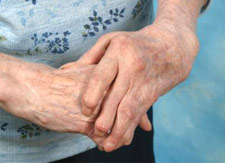


Rheumatoid Arthritis Overview
 Rheumatoid arthritis (RA) is a chronic, systemic inflammatory disorder that may affect many tissues and organs, but principally attacks synovial joints.
Rheumatoid arthritis (RA) is a chronic, systemic inflammatory disorder that may affect many tissues and organs, but principally attacks synovial joints.Rheumatic arthritis can also be explained as an autoimmune disease that causes chronic inflammation of the joints. Rheumatoid arthritis can also cause inflammation of the tissue around the joints, as well as in other organs in the body
The damage is caused by inflammation of the joint lining tissue. Inflammation is normally a response by the body's immune system to "assaults" such as infections, wounds, and foreign objects. In rheumatoid arthritis, the inflammation is misdirected to attack the joints
Onset is most frequent between the ages of 40 and 50, but people of any age can be affected, women three times more often than men. It can be a disabling and painful condition, which can lead to substantial loss of functioning and mobility if not adequately treated
What are the causes of Rheumatoid Arthritis?
Top
The cause of rheumatoid arthritis is not known. It is also suspected that certain infections or factors in the environment might trigger the activation of the immune system in susceptible individuals. These factors include genetics (heredity), hormones (explaining why the disease is more common in women than men), and possibly infection by a bacterium or virus.
What are the sign and symptoms of Rheumatoid Arthritis?
Top
Although rheumatoid arthritis can affect many organs joints are the first to be affected. Rheumatoid arthritis almost always affects the joints of the hands (such as the knuckle joints), wrists, elbows, knees, ankles, and/or feet. The larger joints, such as the shoulders, hips, and jaw may be affected. The vertebrae of the neck are sometimes involved in people who have had the disease for many years.
The symptoms of Rheumatoid arthritis thus can be classified as
The arthritis of joints known as synovitis is inflammation of the synovial membrane that lines joints and tendon sheaths.
The signs of joint inflammation, include:
The symptoms of Rheumatoid arthritis thus can be classified as
- Articular (Joint symptoms)
- Extra Articular
The arthritis of joints known as synovitis is inflammation of the synovial membrane that lines joints and tendon sheaths.
The signs of joint inflammation, include:
- Pain: Aching pain, stiffness, or difficulty moving the joint may develop in one or more joints. The pain may get worse with overuse and may occur at night. With progression of this arthritis, the pain can occur at rest.
- Swelling: the area around the joint becomes swollen and puffy
- Stiffness: the typical stiffness of RA is worse in the morning and improves as the day progresses. It reduces joint mobility and can cause difficulty in daily activity.
- Tenderness
- Redness
- Nodules
- Malaise
- Fever
- Muscle aches
- Weight loss
- Loss of Appetite
How is Rheumatoid Arthritis diagnosed?
Top
There is no single test that can confirm the diagnosis of rheumatoid arthritis. Your health-care professional
will use the results of your interview and physical examination, lab tests, and imaging studies such as
X-rays to determine whether you have rheumatoid arthritis.
Blood test Include:
Complete blood count, ESR, Rheumatoid factor Synovial fluid might be aspirated for studies to evaluate inflammation signs Imaging studies like MRI and CT scan
Blood test Include:
Complete blood count, ESR, Rheumatoid factor Synovial fluid might be aspirated for studies to evaluate inflammation signs Imaging studies like MRI and CT scan
What is the role of Homoeopathy in Rheumatoid Arthritis?
Top
Homoeopathic Approach: As the exact cause of RA is not known, Homoeopathy follows an individualistic approach towards patients suffering from Arthritis we believe that every individual is different and thus a full in-depth case study is the first step. Then referring to the risk factors the individual was subjected too, a particular line of treatment is adopted
Broad criteria of how the homoeopathic medicines act in cases of arthritis are mentioned below. The response to treatment can differ from one individual to other patients are advised to consult so that the mode of treatment can be discussed pertaining to their particular case
Relieves Symptoms like:
a. Pain
b. Stiffness
c. Increases Joint Mobility
d. Tenderness
Preventing exacerbations and attacks in certain forma of arthritis:It helps in preventing any further pain attacks thus improving overall comfortably and mobility of the patient
Controlling and reversing the underlying Disease process:
Our deep acting constitutional medicines act by stopping the demineralization and degeneration process of the bones of the joint involved. It helps in maintaining the joint space and preventing any further loss to the cartilage and synovial fluid. It also provides strength to the adjoining ligaments thus strengthening the whole joint, maintaining its space and decreasing pressure on the nerves.
In mild and moderate disease stages complete cure has been achieved, in cases were the disease process has lead to destruction of the joint as in severe cases were joint destruction and deformity has occurred homoeopathy can offer excellent palliative treatment.
If homoeopathic treatment is sought early it helps in preventing the progress of disease and preventing any complications (joint deformity) from occurring which are usually associated with the disease
We at DRSS provide our patients with diet charts, exercise schedules and guide them how to modify their lifestyle so that better results can be achieved. Our medicines can be started with conventional treatment depending upon the disease state and case.
Homoeopathic medicines if taken under proper guidance from a well-qualified professional are extremely safe and have no side effects.
Broad criteria of how the homoeopathic medicines act in cases of arthritis are mentioned below. The response to treatment can differ from one individual to other patients are advised to consult so that the mode of treatment can be discussed pertaining to their particular case
Relieves Symptoms like:
a. Pain
b. Stiffness
c. Increases Joint Mobility
d. Tenderness
Preventing exacerbations and attacks in certain forma of arthritis:It helps in preventing any further pain attacks thus improving overall comfortably and mobility of the patient
Controlling and reversing the underlying Disease process:
Our deep acting constitutional medicines act by stopping the demineralization and degeneration process of the bones of the joint involved. It helps in maintaining the joint space and preventing any further loss to the cartilage and synovial fluid. It also provides strength to the adjoining ligaments thus strengthening the whole joint, maintaining its space and decreasing pressure on the nerves.
In mild and moderate disease stages complete cure has been achieved, in cases were the disease process has lead to destruction of the joint as in severe cases were joint destruction and deformity has occurred homoeopathy can offer excellent palliative treatment.
If homoeopathic treatment is sought early it helps in preventing the progress of disease and preventing any complications (joint deformity) from occurring which are usually associated with the disease
We at DRSS provide our patients with diet charts, exercise schedules and guide them how to modify their lifestyle so that better results can be achieved. Our medicines can be started with conventional treatment depending upon the disease state and case.
Homoeopathic medicines if taken under proper guidance from a well-qualified professional are extremely safe and have no side effects.

Rheumatoid Arthritis




